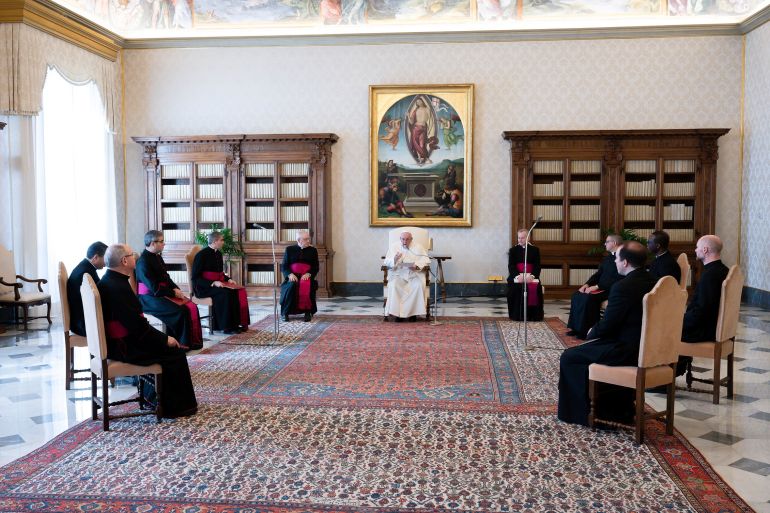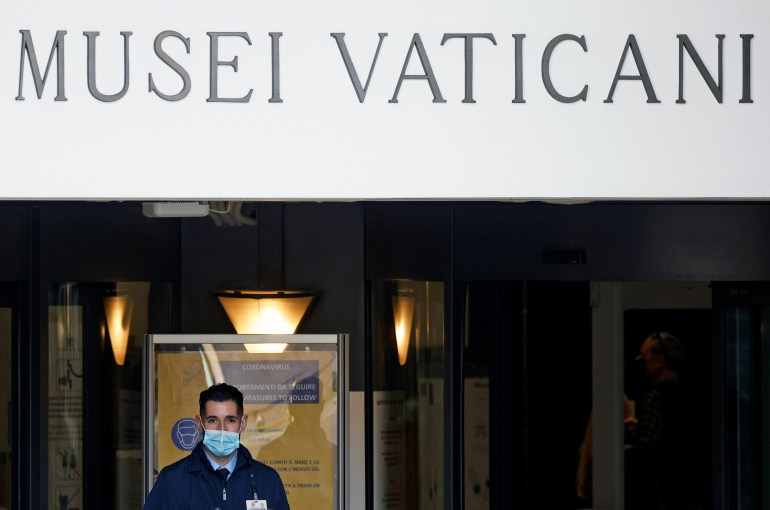Pope orders pay cut for cardinals, clerics to save other jobs
Pope Francis has said that he does not want to fire people in difficult times, even as the Vatican faces a big deficit.

Pope Francis has ordered cardinals to take a 10 percent pay cut and reduced the salaries of most other clerics working in the Vatican in order to save employees’ jobs as the coronavirus pandemic has hit the Holy See’s income.
The Vatican said on Wednesday that Francis issued a decree introducing proportional cuts starting on April 1. A spokesman said most lay employees would not be affected by the cuts.
Keep reading
list of 4 itemsPope Francis urges Iraq’s Muslims, Christians to unite for peace
Former head of Vatican bank found guilty of embezzlement
Pope says women can read at mass, but still cannot be priests
A senior Vatican prelate said it was believed to be the first time in living memory that a pope had taken such action.
Francis, 84, and from a working-class family, has often insisted he does not want to fire people in difficult economic times, even as the Vatican continues to run up deficits.
Cardinals who work at the Vatican and live there or in Rome are believed to get salaries of about 4,000 to 5,000 euros ($4,730 to $5,915) a month, and many live in large apartments at rents that are well below market value.
Most priests and nuns who work in Vatican departments live in religious communities in Rome, such as seminaries, convents, parishes, universities and schools – giving them greater protection from economic downturns.
They have much lower living expenses than lay employees – such as police, ushers, firefighters, cleaners, art restorers and maintenance personnel, who live in Rome and who often have families.
It is these lay workers who the pope appeared to want to protect, as most of their employment levels were not listed in the papal decree. Vatican pay grades go from levels 1-10 for most employees. Senior positions have four grades, from C to C-3.
Apart from the cardinals, other clerics will see their salaries reduced by between 3 percent and 8 percent. Programmed pay rises for all but the three lowest pay grades will be suspended until March 2023.
Museums closed by pandemic
The Vatican’s top economic official said earlier this month that the Holy See, the central administrative body of the worldwide Roman Catholic Church, may have to use 40 million euros ($47m) in reserves for the second straight year as the COVID-19 pandemic burns through its finances.

It expects a deficit of about 50 million euros ($59m) this year. Revenues are expected to be about 213 million euros ($252m) in 2021, down 30 percent over 2020.
St Peter’s Basilica and the Vatican Museums, the latter a cash cow that received about six million paying visitors in 2019, were closed or only partially open for much of 2020 because of the pandemic. The museums had been due to reopen this month but remained closed because of a new lockdown by Italy.
In a seven-point preface to the decree explaining why action was needed now, Francis said the pandemic “has negatively affected all the sources of income of the Holy See and the State of Vatican City”.
He said that, while both currently had “adequate capitalisation”, he felt the duty to guarantee “sustainability and equilibrium between income and expenses” in the current economic climate.
Last year, top Vatican administrators ordered a freeze on promotions and hirings and a ban on overtime, travel and large events in an attempt to contain costs.
The Holy See budget covers entities in Rome that oversee the governing of the 1.3 billion-member worldwide church, its diplomatic representations, and media operations.
Vatican City, including the Vatican Museums and the Vatican Bank, has a separate budget, although income from both is often transferred to the Holy See to help plug deficits.
The Holy See’s income is from donations, real estate management and investments.